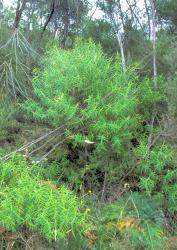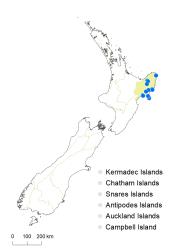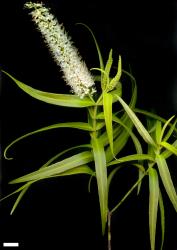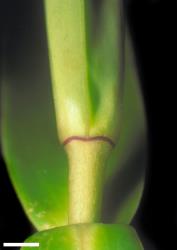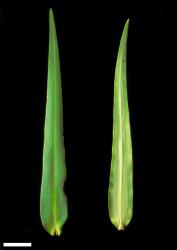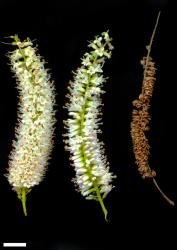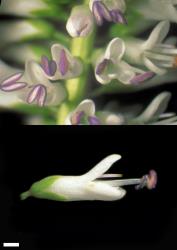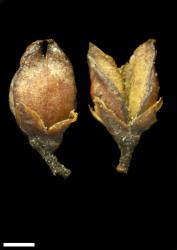- ≡ Hebe tairawhiti B.D.Clarkson & Garn.-Jones, New Zealand J. Bot. 34: 51 (1996)
Bushy shrub to 3 m tall. Stems erect, eglandular-pubescent; hairs bifarious or uniform. Leaf bud distinct, its leaves appressed at margins until fully grown; sinus absent. Leaves opposite-decussate, spreading to recurved; lamina sub-coriaceous, linear-lanceolate, tapering evenly from base, 45–150 mm long, 5–11 mm wide, dull, green above, paler beneath; midrib and secondary veins evident; surfaces glabrous or with short eglandular and sessile glandular hairs along midrib above; margin puberulent, entire or sometimes with distant, slightly prominent to depressed hydathodes; apex very narrowly acute to weakly plicate-acuminate with large, blunt hydathode; base abruptly cuneate to rounded; petiole indistinct, broadly winged, 0–1.5 mm long. Inflorescence a lateral raceme, 68–150 mm long; flowers crowded, 120–180, all bisexual; bracts alternate and sometimes loosely whorled, linear to narrowly deltoid, usually <, sometimes > pedicels; pedicels erecto-patent to spreading, 1.3–3.0 mm long, puberulent all around. Calyx lobes 4, acute to weakly acuminate, 1.2–1.7 mm long, sub-equal, mixed glandular- and eglandular-ciliate. Corolla 2.5–4.0 mm diameter; tube white, 3.0–3.5 mm long, > calyx, hairy inside; lobes 4, white, sometimes pale purplish at anthesis, erect to erecto-patent, unequal, narrowly elliptic to ovate or narrowly oblong, 1.8–3.0 mm long, sub-acute; nectar guides absent. Stamen filaments white, 3–5 mm long; anthers purplish. Style glabrous, 3.5–7.0 mm long. Capsules latiseptate, sub-acute to acute, glabrous, 2.7–5.2 mm long, 1.8–2.6 mm at widest point. Seeds discoid, obovoid, or ellipsoid, flattened, smooth, straw-yellow to brown, 0.8–1.2 mm long.
In their growth form and flower shape, V. tairawhiti plants are very similar to plants of V. stricta and V. angustissima.
V. stricta plants differ in having leaves that are usually broader and are widest in the middle third. In the region of geographical overlap the calyx lobes in V. stricta plants are hairy on the outer faces.
V. angustissima plants are smaller shrubs, with softer and thinner leaves that are broadest some distance from the base; they usually have longer pedicels and fewer than 100 flowers per inflorescence. The distributions of V. angustissima and V. tairawhiti do not overlap, because V. angustissima occurs further west, in eastern Bay of Plenty, and further south, in the Wellington region.
North Island: Gisborne (from Maraehara River to Māhia and near Wairoa).
Shrubby vegetation on coastal cliffs and inland on river banks, road cuttings, and rock outcrops. Recorded elevations range from 5 to 549 m.
Flowers: January–April; fruits: February–May, persisting to December.
2n = 80 (see Bayly & Kellow 2006, as Hebe tairawhiti).
Veronica tairawhiti is classified in V. subg. Pseudoveronica sect. Hebe and the informal group “Occlusae” (Albach & Meudt 2010; Bayly & Kellow 2006).
The midrib is often yellowish, and this is also seen in V. flavida and V. ligustrifolia, both of which grow in Northland and have wider leaves and larger flowers.
The Māori names koromiko, kōkōmuka, and variants, applied to V. stricta and V. salicifolia, might be applied also to similar large-leaved hebes, such as V. tairawhiti.



